One memorable experience from my fieldwork in the Kargil Suru Valley involved the fascinating courtship behavior of Eurasian Magpies. When the snow had just begun to melt in the spring, I spent early mornings observing these intelligent birds. One particular pair caught my attention. The male magpie was determined to win over his female. Each time, he would search for the shiniest objects he could find pieces of glass, small metallic trinkets, and even colorful plastic bits. With each treasure in his beak, he would return to their nesting site, perched high in a Populus tree.
What was truly captivating was the ritualistic nature of his gift-giving. The male would approach the female with a series of elaborate movements, bobbing his head, flapping his wings, and making soft, cooing sounds.
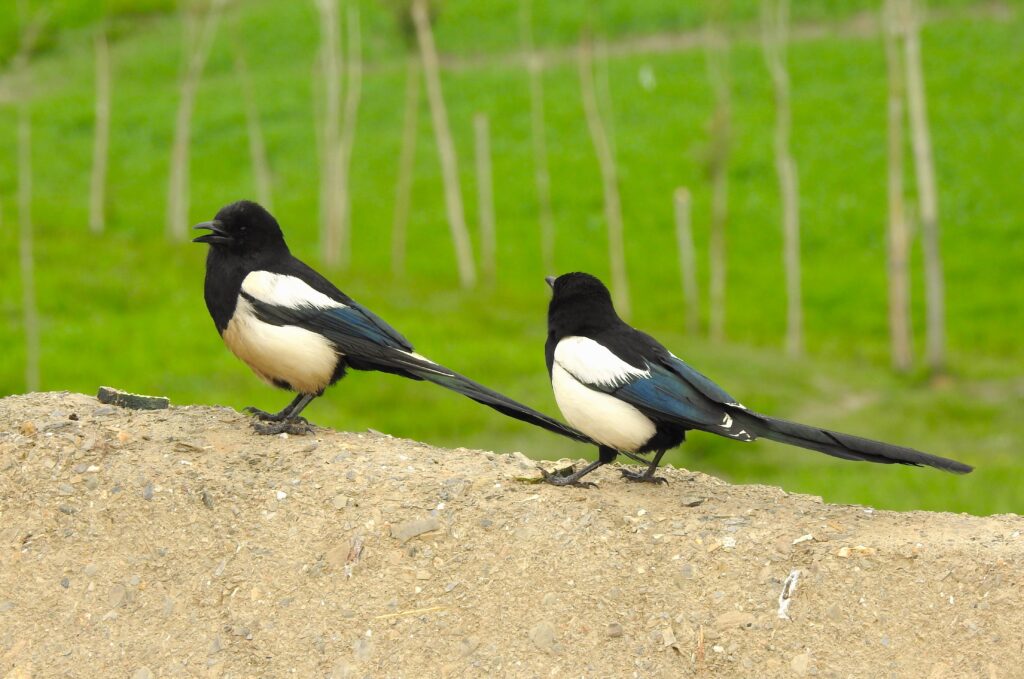 A pair of Eurasian Magpies, with the male on the left, often attracts his mate through singing. Although Eurasian Magpies are monomorphic – meaning males and females look nearly identical – they can be distinguished by subtle differences. The adult breeding male typically has a slightly longer tail (about 1.5 inches longer than the female). However, the most reliable way to differentiate between the sexes is by observing their behaviors, particularly during mating and courtship.
A pair of Eurasian Magpies, with the male on the left, often attracts his mate through singing. Although Eurasian Magpies are monomorphic – meaning males and females look nearly identical – they can be distinguished by subtle differences. The adult breeding male typically has a slightly longer tail (about 1.5 inches longer than the female). However, the most reliable way to differentiate between the sexes is by observing their behaviors, particularly during mating and courtship.
He then presented the shiny object to the female, placing it gently on the ground near her. The female, in turn, would inspect the gift with great interest, often picking it up and carrying it back to their nest. This wasn’t just a one-time event. I observed the male bringing numerous gifts, each time performing his courtship dance with the same enthusiasm. This collection of shiny objects not only adorned their home but also strengthened their bond. Watching this pair of magpies, I was struck by the complexity of their interactions and the evident care they took in building their relationship. It was a beautiful reminder of the intricate and emotional lives that birds lead, often mirroring human behaviors in their unique ways. This experience not only deepened my understanding of Eurasian Magpies but also reinforced the importance of observing and preserving these incredible creatures and their habitats. Moments like these highlight the wonders of the natural world and the rich, unseen stories that unfold within it.
This is how my love for birds and nature took shape..
I come from a small village called Goshan, located in the Drass Valley of Kargil, Ladakh. This area was deeply affected by the 1999 Kargil War during Operation Vijay, and growing up in such a historic and mountainous region left a lasting impact on me. From my balcony, I could see the iconic Tiger Hill and the Tololing Mountain Range, which fueled my fascination with the majestic Himalayas. This connection to the mountains played a significant role in shaping my passion for nature and conservation.
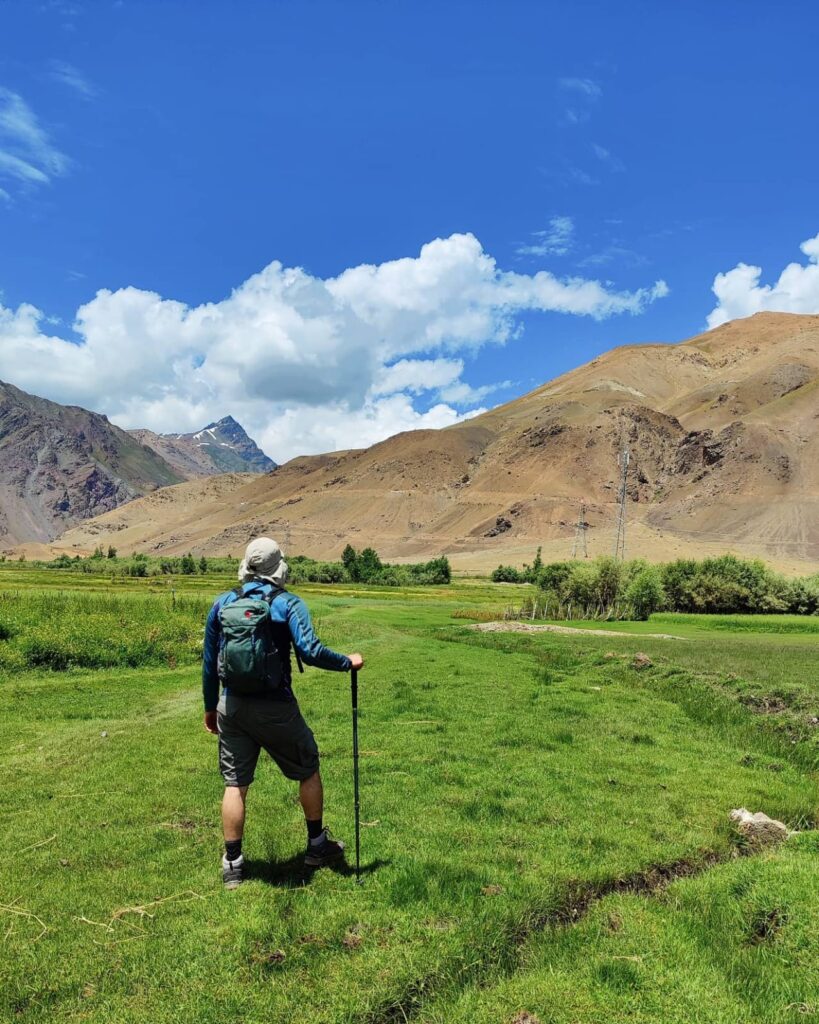 View of Tiger Hill Mountain Peak from Goshan Village
View of Tiger Hill Mountain Peak from Goshan Village
My interest in birds and nature began in 2014, during the middle of my bachelor’s studies. At that time, I used my father’s antique pair of metallic binoculars to scan the mountains and observe birds, which sparked my passion for birdwatching. I pursued a B.Sc. at Govt. Degree College Kargil, with subjects in Chemistry, Zoology, Botany, and English. Initially, the college was affiliated with the University of Kashmir, but it is now under the University of Ladakh.
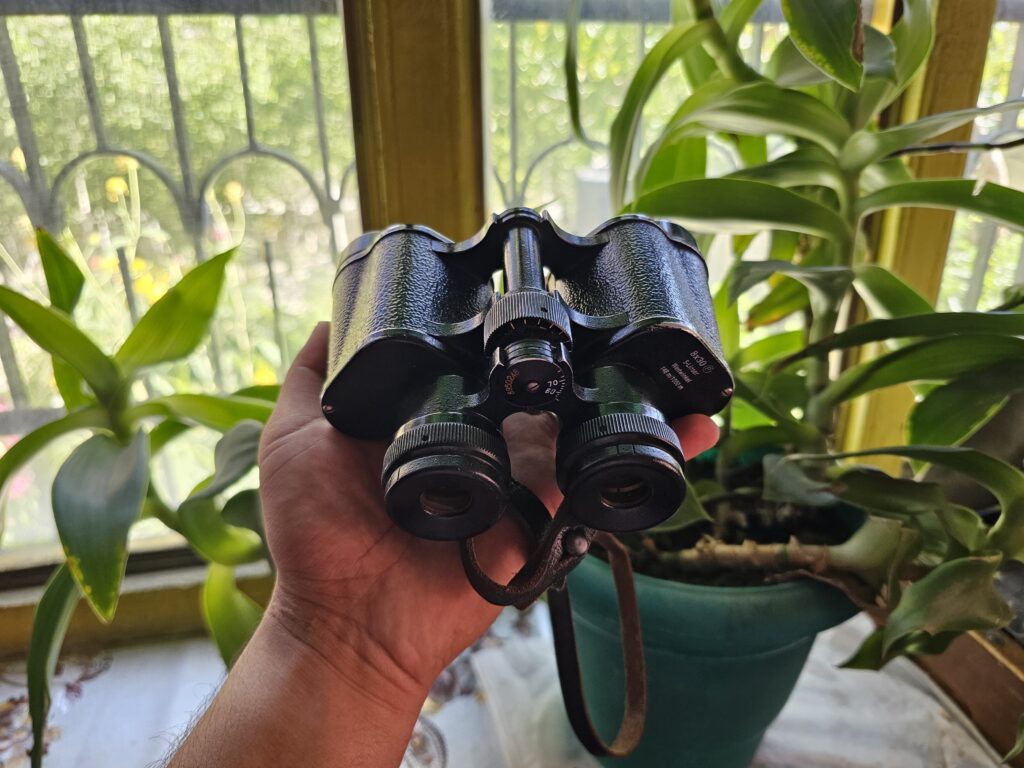 My father’s Binocular (8×30 Weitwinkel) The binocular still works perfectly fine.
My father’s Binocular (8×30 Weitwinkel) The binocular still works perfectly fine.
I would spend hours watching these beautiful creatures, captivated by their vibrant colours and unique morphological features. To capture these details, I began sketching the birds in a dedicated sketchbook, carefully noting their distinguishing characteristics. During that period, the internet was not as accessible at home as it is today. Instead, I would make trips to local cyber cafes to conduct my research. These visits became an essential part of my routine as I would use the limited time available to search for and identify the birds I had sketched. The process of matching my drawings with online images and information was both challenging and rewarding, as each successful identification felt like a small victory. This routine of observing, sketching, and researching birds gradually grew into a profound passion. Over the years, what started as a simple curiosity evolved into a deep and lasting love for birdwatching and identification. This passion not only enriched my appreciation for nature but also laid the foundation for my future in ornithological research.
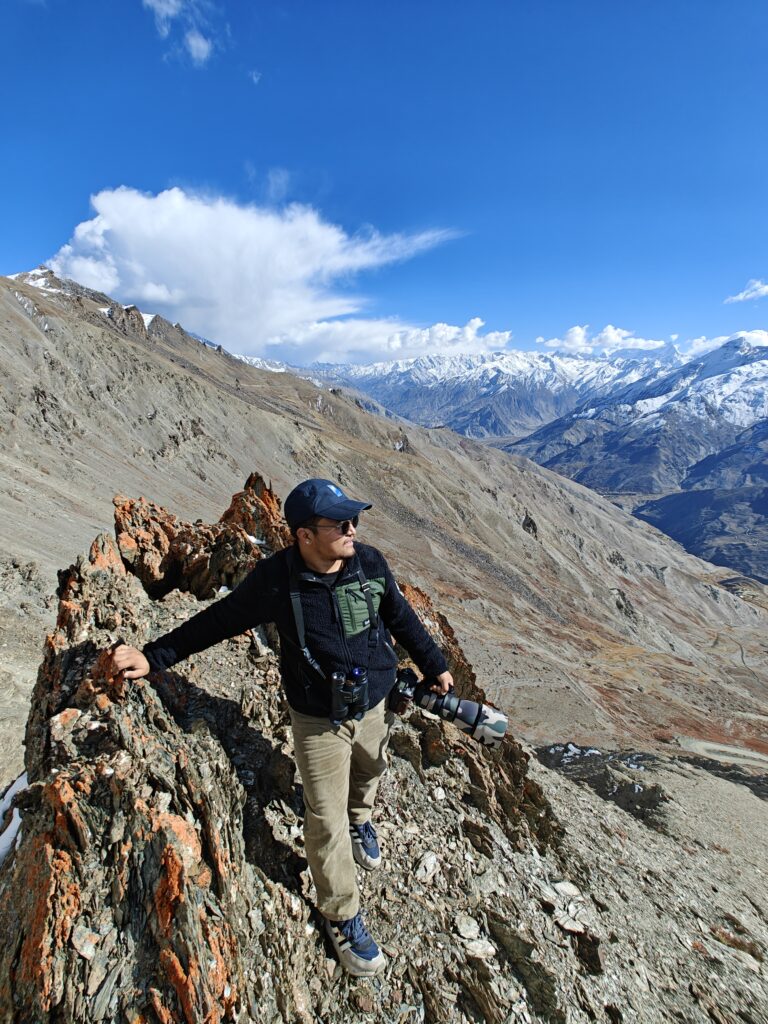 Searching for Himalayan Snowcock at Umba La Pass Kargil, Ladakh, 2023
Searching for Himalayan Snowcock at Umba La Pass Kargil, Ladakh, 2023
My interest in birds naturally evolved into a research direction during my last year of graduation. By that time, birdwatching had become a regular activity for me, often done at home and sometimes during weekends with Professor Deskyong Namgyal, my Zoology teacher. Professor Namgyal played a pivotal role in deepening my connection with birds and inspired me to consider a future in ornithological research. After completing my graduation, I moved to Dehradun for my master’s studies, where I completed an M.Sc. in Zoology from the Department of Zoology at DAV PG College, Dehradun. The college is affiliated with Hemwati Nandan Bahuguna Garhwal University. Upon finishing my master’s, I received a Junior Research Fellowship (JRF) opportunity at the Zoological Survey of India, Dehradun Centre. I was part of a project assessing bird sanctuaries in Uttar Pradesh, Uttarakhand, Delhi, and Chandigarh under the guidance of Dr. Anil Kumar, who is renowned for his work on the bird fauna of the Western Himalayas. Working closely with Dr. Kumar significantly broadened my understanding of bird research, methods, and behavioural observations. Once the project ended, I began searching for PhD opportunities. In 2019, I registered for a PhD with the Department of Zoology at Gurukula Kangri University under the supervision of Prof. Dinesh Bhatt, who is well known for his research in birds and bird bioacoustics. Dr. Anil Kumar was my co-supervisor for the PhD. I chose the Eurasian Magpie as my species of interest.
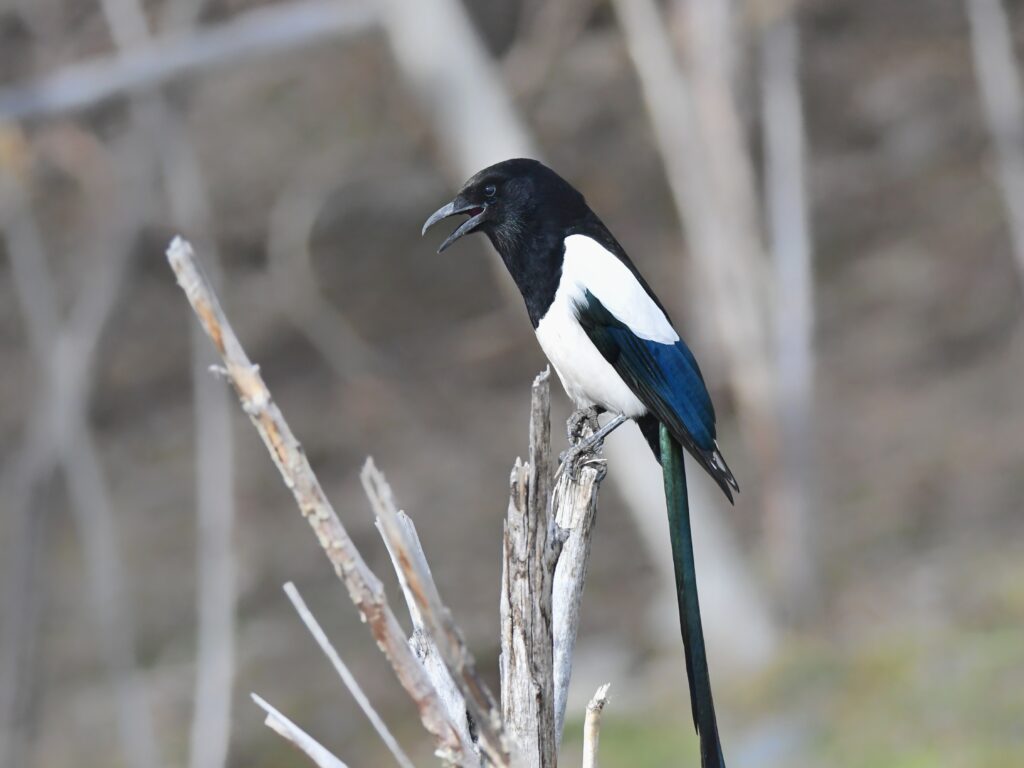 Eurasian Magpie (Pica Pica) . This resident bird, found across Europe and Asia, has a population in India that is restricted to the Ladakh Region. My research now focuses on this fascinating species, delving into its behaviours and ecological significance in the region. To read my publications, here is my ResearchGate profile.
Eurasian Magpie (Pica Pica) . This resident bird, found across Europe and Asia, has a population in India that is restricted to the Ladakh Region. My research now focuses on this fascinating species, delving into its behaviours and ecological significance in the region. To read my publications, here is my ResearchGate profile.
Currently, I am working as a Himalaya Landscape advisor with The Nature People Network NGO, focusing on a comprehensive conservation initiative in North West India’s Kargil Ladakh Region.
- This project aims to collaborate closely with local communities to ensure the long-term preservation of the Rangdum wetland and its surrounding glaciers. One of our primary goals is to document lesser-known plant species in the region, contributing valuable data to our understanding of local biodiversity. Additionally, we are exploring and implementing sustainable livelihood opportunities for the local communities, which is crucial for fostering economic resilience and reducing dependence on environmentally harmful practices.
- A significant aspect of our project is regulating responsible tourism by sensitizing local communities to the environmental impacts of tourism. By promoting responsible practices, we aim to balance tourism development with ecological preservation.
- Another crucial focus of our project is addressing human-wildlife conflict. By developing and promoting strategies to mitigate these conflicts, we aim to create a more harmonious coexistence between the local populations and wildlife, ensuring both can thrive.
- Moreover, we are tackling the pressing issue of local black carbon emissions. These emissions are particularly harmful to the nearby glaciers, accelerating their melting and contributing to climate change. Our project includes initiatives to reduce these emissions through cleaner technologies and practices, helping to protect the fragile glacier ecosystems. This multifaceted approach not only aims to conserve the natural environment but also to enhance the quality of life for the local communities, creating a sustainable model for conservation in the region.
I love what I do because..
What I enjoy the most about my work is the field trips and surveys, particularly the early morning birding excursions. Exploring new places to observe and photograph birds is incredibly exciting, and the omnipresent nature of birds never ceases to amaze me, inspiring me to explore every landscape.
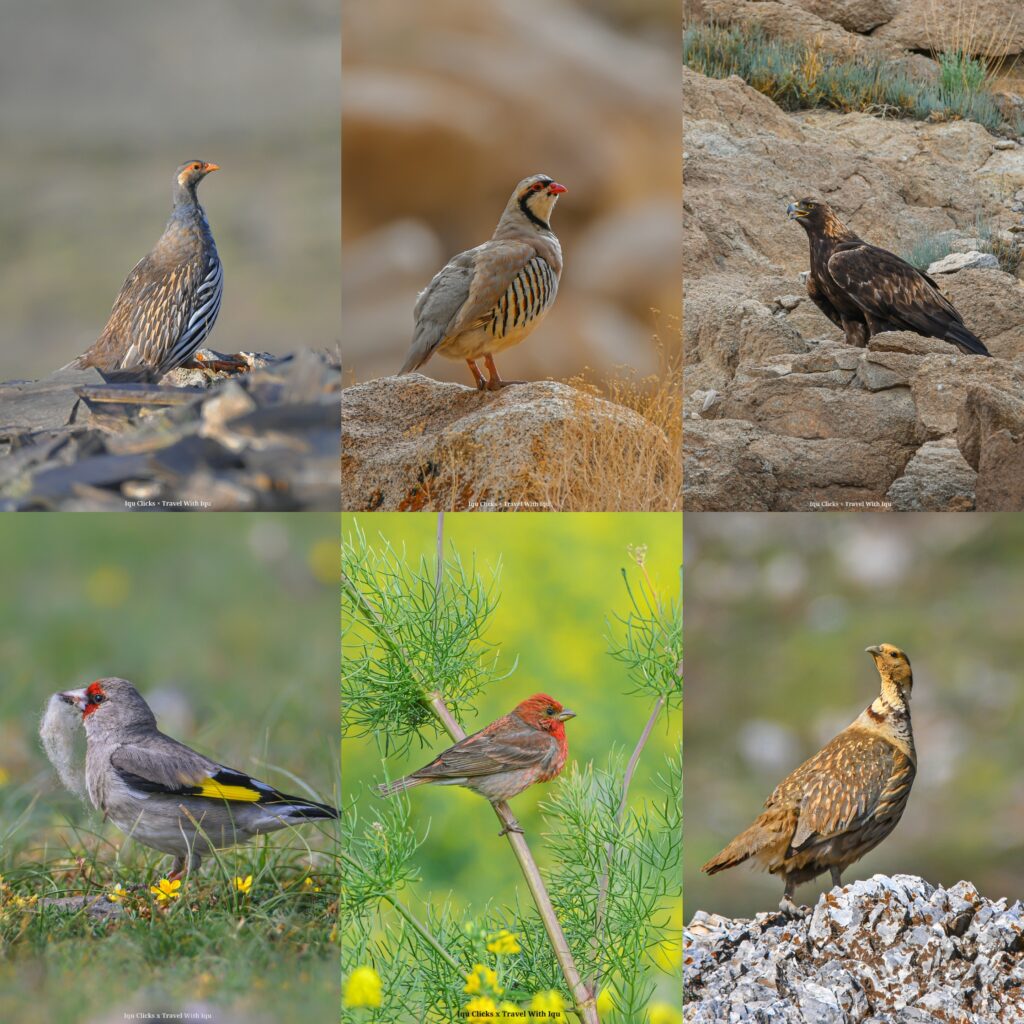 A few Trans-Himalayan birds clicked along the field surveys and tours.
A few Trans-Himalayan birds clicked along the field surveys and tours.
From L to R (Row 1: Tibetan Snowcock, Chukar Partridge, Golden Eagle; Row 2: Himalayan Goldfinch, Common Rosefinch, Himalayan Snowcock)
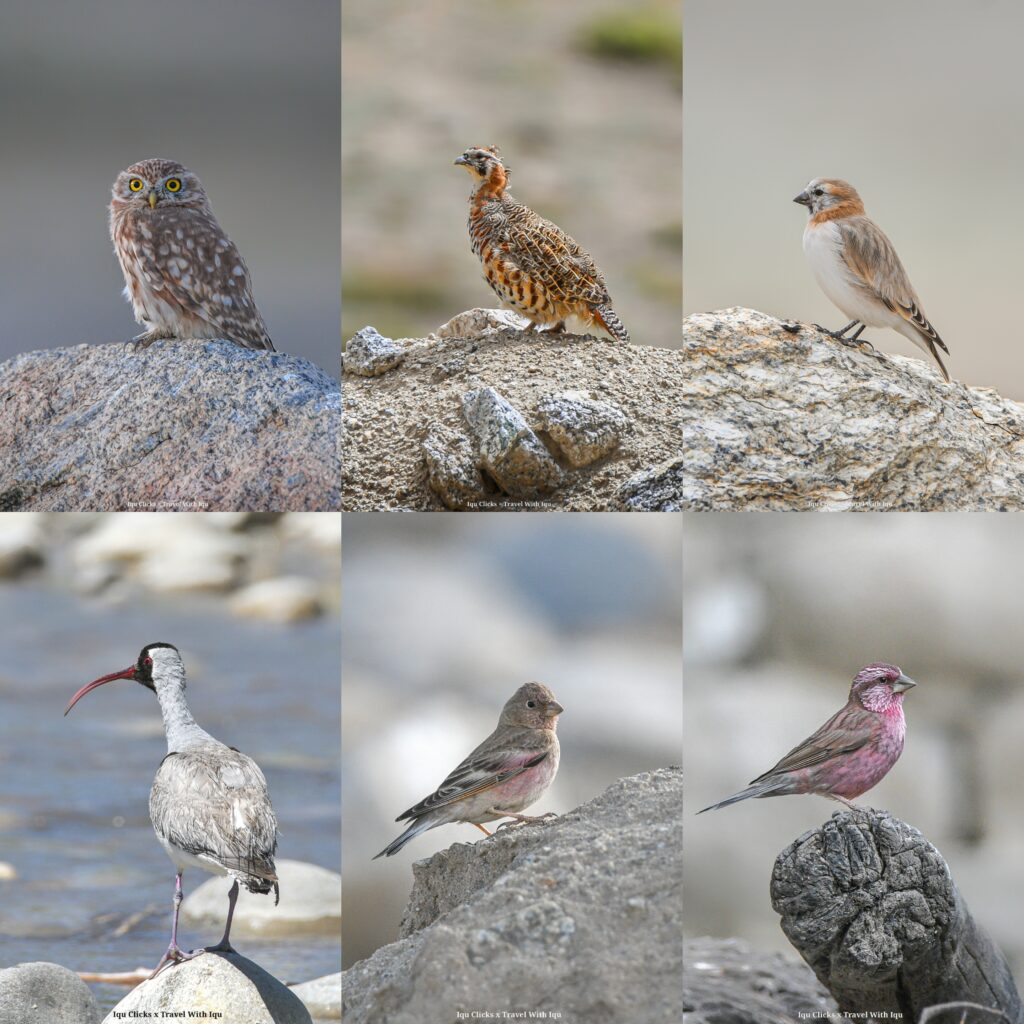 From L to R (Row 1: Little Owl, Tibetan Partridge, Blanford’s Snowfich; Row 2: Ibisbill, Mongolian Finch, Blyth’s Rosefinch)
From L to R (Row 1: Little Owl, Tibetan Partridge, Blanford’s Snowfich; Row 2: Ibisbill, Mongolian Finch, Blyth’s Rosefinch)
Additionally, I love engaging with local communities, listening to their stories, and learning about their unique practices, languages, food habits, and plant uses. This exchange of knowledge is invaluable, and I always strive to learn as much as I can from them.
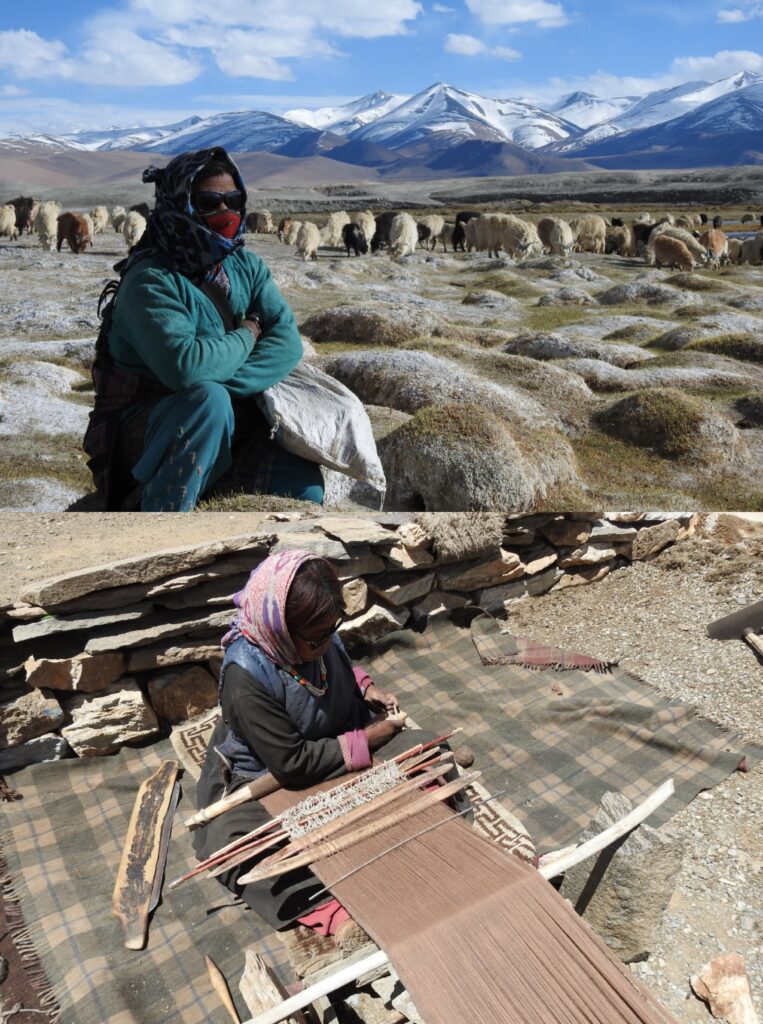 Top: Nomadic lady herder at Tsokar Lake, Bottom: Changpa Tribe women, making rugs from wool. Both photographs taken during a field survey.
Top: Nomadic lady herder at Tsokar Lake, Bottom: Changpa Tribe women, making rugs from wool. Both photographs taken during a field survey.
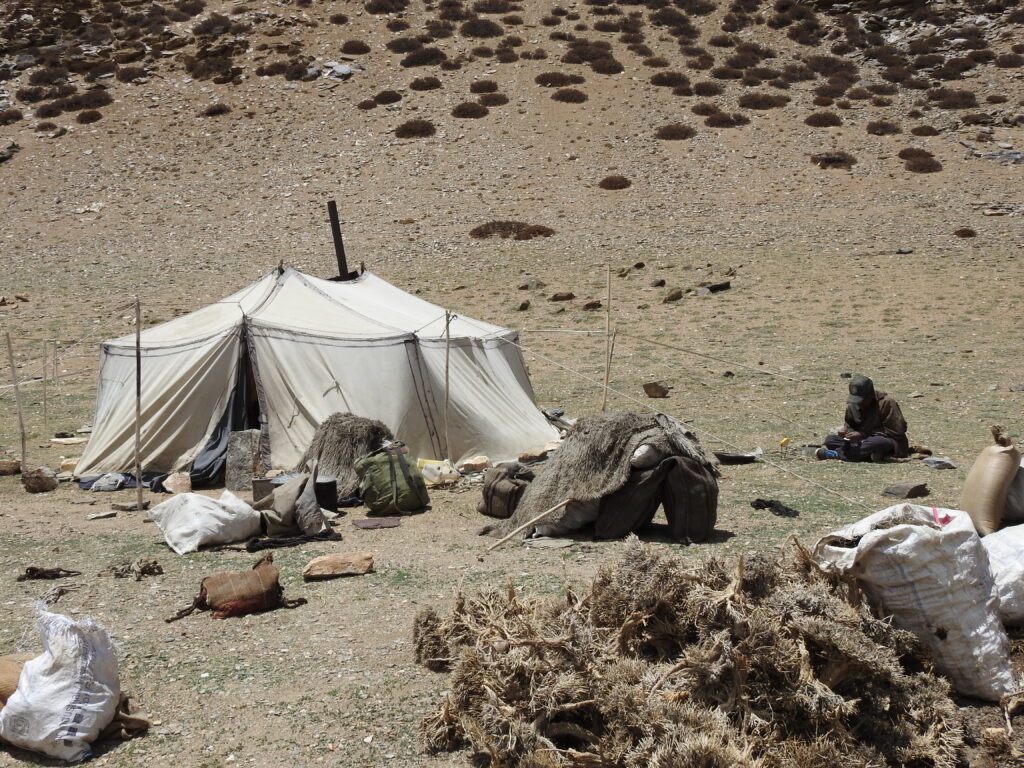 Typical lifestyle of nomads in Changthang Valley of Ladakh
Typical lifestyle of nomads in Changthang Valley of Ladakh
Challenges I have faced..
During my PhD research, one of the key challenges I faced was a lack of funding in the early stages, which was resolved after I qualified for the Ministry of Tribal Affairs’ NFST fellowship. Prior to securing this fellowship, I worked as a bird guide to fund my travels to remote areas like Changthang. In 2020, I was also featured as India’s favorite bird expert in Sanctuary Asia Magazine.
Along with financial constraints, I encountered logistical difficulties conducting research in remote regions with limited infrastructure, such as Eastern Ladakh, Hemis National Park, and Zanskar, where rough terrain and unpredictable weather often posed obstacles. To overcome these challenges, I built strong relationships with local communities, who generously supported me with transportation, accommodation, and vital local knowledge. I also sought guidance from mentors and leveraged my network to keep the research moving forward. In Ladakh’s harsh environment, I extended my field visits, adjusted my schedule to take advantage of favorable weather, and made efficient use of limited resources.
For specialized tasks, such as collecting data from tall Populus trees-where Eurasian Magpies typically nested at heights of 15 meters, I sought assistance from professional climbers. The steep and rugged terrain made it physically demanding to set up cameras or check the nests for breeding success. Despite these obstacles, overcoming these challenges provided valuable insights into the nesting behaviors and breeding success of the Eurasian Magpie, significantly contributing to my research.
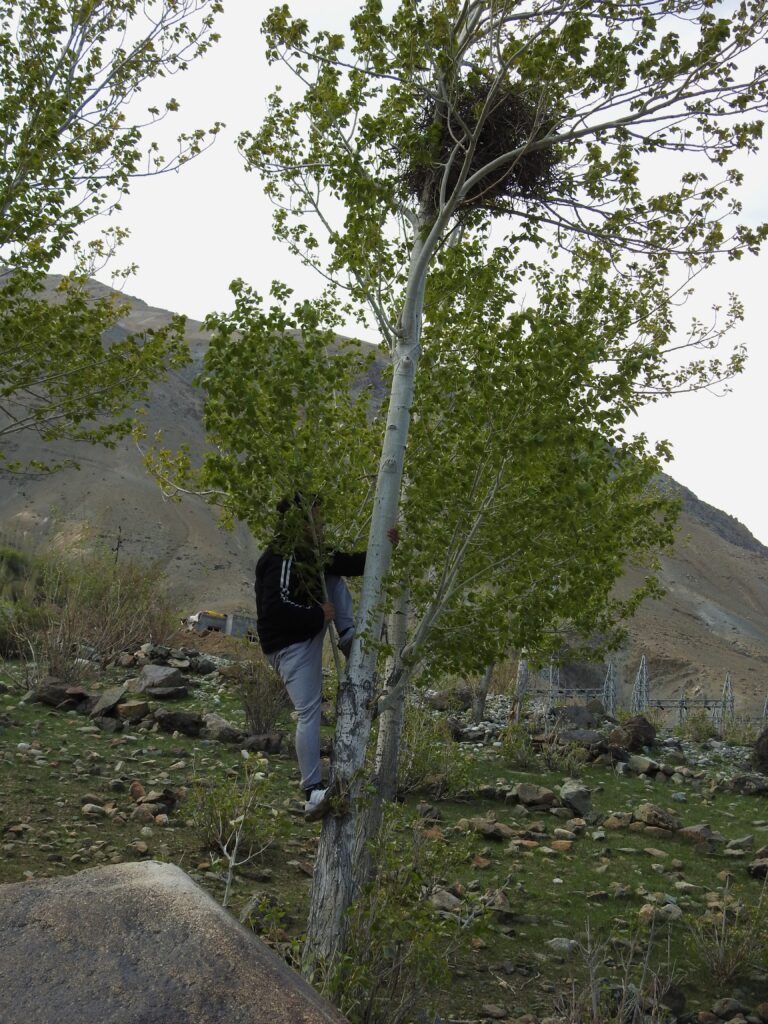 Observing the active nest of Eurasian Magpie in Suru Valley, Kargil
Observing the active nest of Eurasian Magpie in Suru Valley, Kargil
My advice to young researchers is..
For young researchers aspiring to pursue a career in ornithology, my foremost advice is to stay positive and work hard. Initially, everything might seem tough and daunting, but once you commit yourself to facing these challenges head-on, nothing is impossible.
Should Do:
Conduct Thorough Literature Reviews: Before setting up your objectives, ensure you have a comprehensive understanding of existing research. This will help you refine your focus and contribute meaningfully to the field.
Work with Passion: Even if you do less, do it with full passion and dedication. The quality of your work is far more important than the quantity.
Stay Resilient: Fieldwork can be physically and mentally demanding, especially in challenging environments like the Trans Himalaya. Stay resilient and adaptable, and learn from every experience.
Network and Collaborate: Build connections with other researchers and professionals in the field. Collaborations can open new opportunities and provide valuable insights.
Embrace Technology: Utilize the latest tools and technologies for data collection and analysis. Staying updated with technological advancements can significantly enhance your research.
Should Not Do:
Avoid Rushing: Don’t rush your work to produce more results. Focus on producing high-quality, well-documented research that adds value to the field.
Don’t Get Discouraged by Setbacks: Research often involves facing setbacks and challenges. Don’t get discouraged; instead, view them as learning opportunities.
Don’t Neglect Field Safety: Always prioritize safety during fieldwork. Ensure you have the necessary equipment and take precautions to avoid accidents.
Remember, the journey of research is as important as the destination. Stay curious, passionate, and committed to your work, and you’ll make meaningful contributions to ornithology.
Dr. Iqbal Ali Khan
[email protected]
Himalayan Landscape Advisor, The Nature People Network
Social Media Links:
ResearchGate profile
Youtube Channel
Instagram
Wildlife Blog
Facebook
Twitter

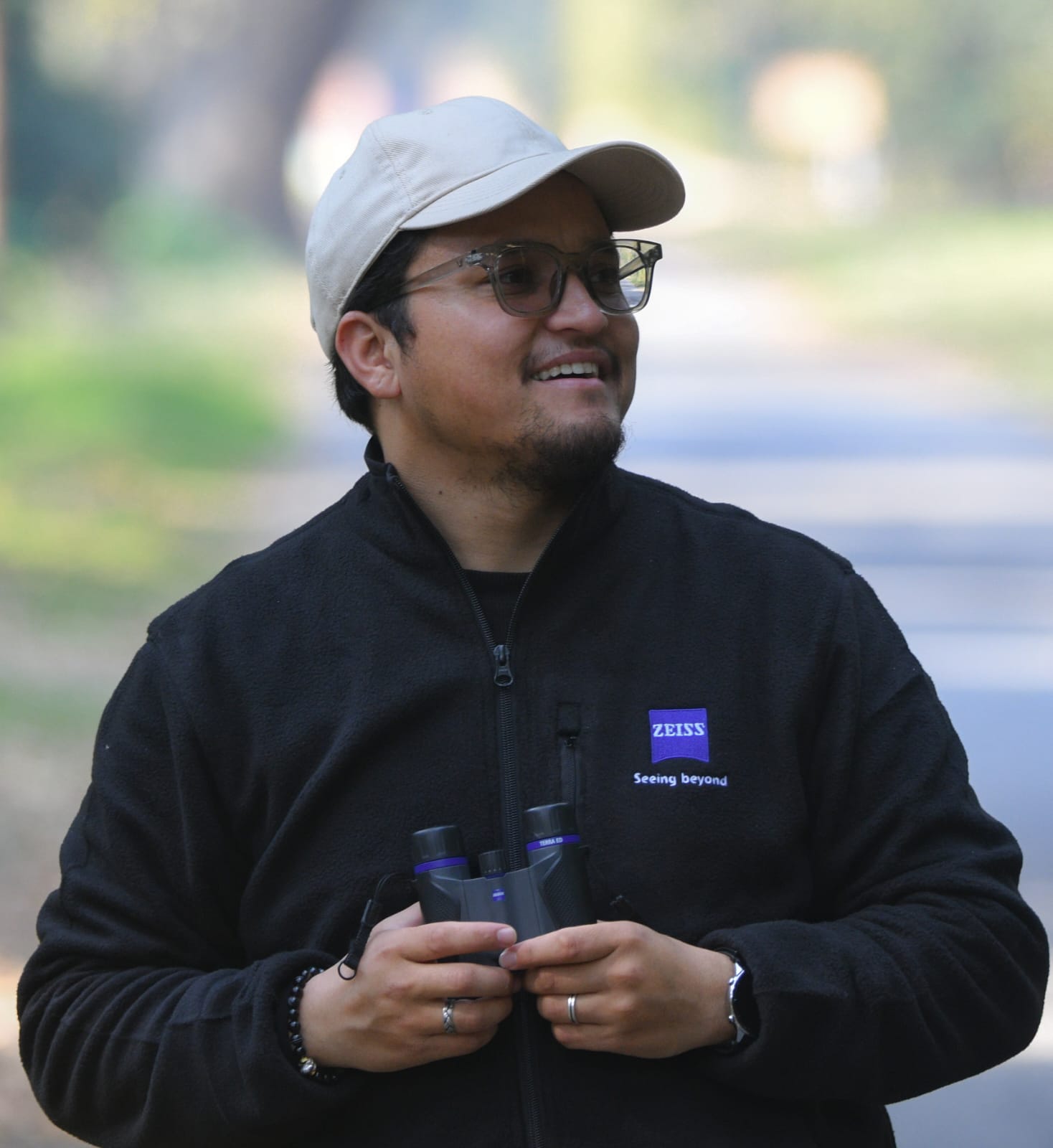
Amazing journey ka Iqbal 😍💐
As a researcher I found it very pragmatic for my PhD journey, and also fascinating stories you share with us is commendable, You deserve more than this go ahead.
Great work, certainly worthy of praise best of luck for the bright future ahead iqu ♥️👍🏼💐
Wow beautiful dear nono Dr. Iqbal Ali Khan, very nicely projected your journey in a precise manner.
Very hardworking and knowledgeable person. Love to be a part of your journey in early days.
I wish him BEST OF LUCK. Truly a gem for Ladakh region.
Good read. I am sure young researchers will find your experience and the way you have overcome challenges, inspiring. My compliments and best wishes.